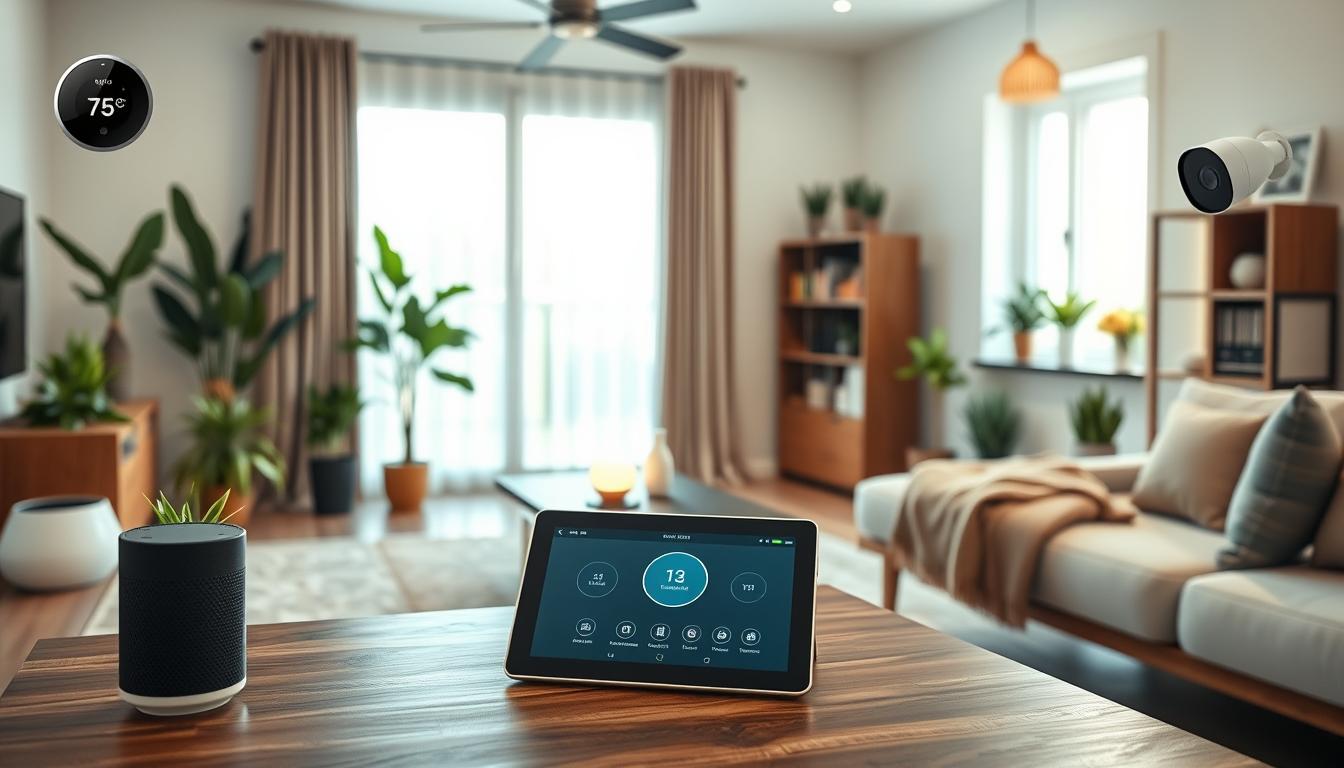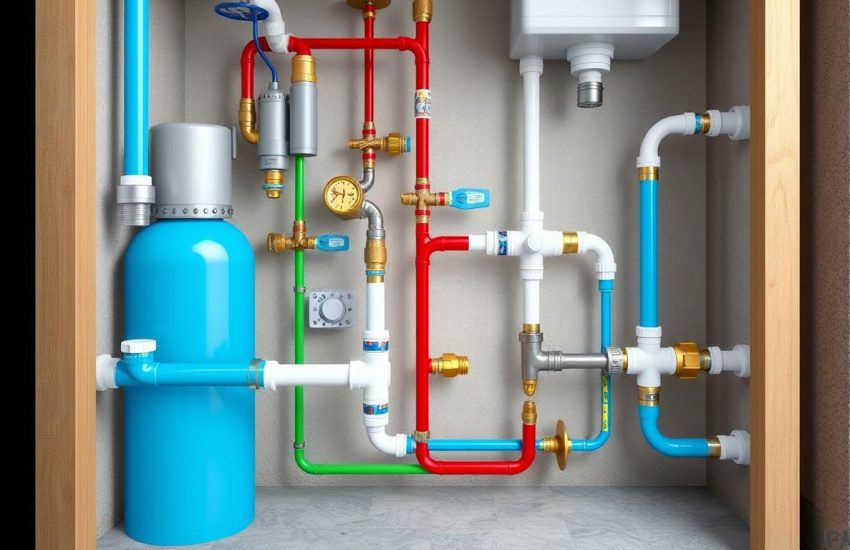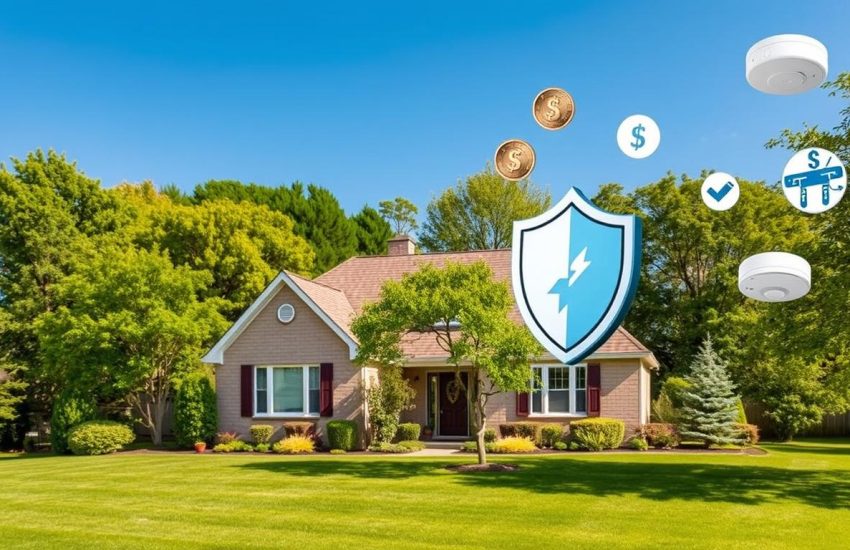Smart Home Technology: A Complete Guide for Homeowners
Imagine if your house could learn what you like and make your life easier. Smart home technology is making this idea real. It’s changing home automation. The whole world is starting to love smart devices. This isn’t just a small change; it’s a big movement with lots of possibilities.
People want their homes to be comfier and smarter. They’re using technology to do this. The interest in smart home technology is growing fast. By 2025, almost half of all US houses will use this technology. This shows how managing homes is changing.
There are now over 300 million smart homes around the world. Home automation is becoming normal, not just fancy. The global market could reach over 135 billion USD. People really want homes that are connected and easy to manage digitally.
Key Takeaways
- Understanding of the burgeoning smart home technology landscape and home automation trends.
- Consumer spending on smart devices underscores their expectation for increased home security, efficiency, and convenience.
- Technological advancements are driving a remarkable increase in the smart home market’s value.
- The growing consumer trends for smart homes point to a significant lifestyle transition.
- Insights into why homeowners and builders alike are investing more heavily in smart technology integration.
- Recognition of the crucial role of privacy, data security, and industry standards in the adoption of smart home systems.
Why Focus on Smart Home Technology?
Smart home tech is a big part of modern living. It gives us convenience, security, and helps save on energy. This makes it key for home improvement. Thanks to smart home devices, managing our homes is easier and safer.
Smart home tech blends into our daily lives well. You can manage lights, heat, and security from anywhere. This also cuts down on energy costs. For example, smart thermostats adjust temperature automatically, saving money on bills.
For security, devices like smart locks and cameras offer peace of mind. They let homeowners monitor their space realtime, whether home or away. So, more people are getting into smart home tech.
Even though starting can be pricey, the long-term savings matter. Smart homes use less energy, thanks to automated systems. This ups the savings.
New tech standards like Matter are supported by big companies such as Amazon, Apple, and Google. They make devices easier to use together. This helps solve previous issues with compatibility.
Smart homes are even shaping how we design new houses. Many new homes come ready for smart tech. This makes living better and can up home values. Nowadays, buyers want homes with smart capabilities.
In sum, adding smart home tech to our homes offers lots of benefits. It makes living easier, safer, and can save money. As tech gets better, these gadgets become must-haves for a modern home.
DIY vs Professional Help
Homeowners choosing smart home tech face an important decision. Do they go the DIY smart home technology route or opt for professional installation? Both choices have unique benefits fitting various needs. Let’s delve into each option, with data on technology integration and company insights, like from Princeton Electrical Makeover.
Understanding DIY Installations: Did you know 60-70% of devices like smart bulbs and speakers are easy for homeowners to install? These options are not just affordable smart home technology, but also let you learn and customize freely. Yet, DIY means you need to know a bit about networking and how devices work together, which can be tough.
Benefits of Professional Installations: Meanwhile, 30-40% of people choose pros for complex setups like smart thermostats. Experts from Princeton Electrical Makeover ensure your tech works well together. It’s usually more costly upfront, but you get a reliable, enhanced system. This can up your home’s value and living quality.
Smart home devices improve health and comfort. Things like air purifiers and sleep trackers might need experts to set up right.
Consider these facts:
| Installation Type | Ease of Setup | Cost Consideration | Percentage of Homeowners Choosing This Method |
|---|---|---|---|
| DIY Installations | User-friendly | Lower upfront costs | 70% (for standalone devices) |
| Professional Installations | Requires expertise | Higher upfront costs | 40% (for complex systems) |
Your choice between DIY and pro installs hinges on your tech comfort, system complexity, and budget. No matter your choice, making technology integration work well for you is key. You’ll enjoy all the perks of affordable smart home technology.
How to Save Money
Smart home technology is more than just for convenience. It helps save money on smart home technology. The costs at first seem high. But, you will save a lot on utility bills later.
Think about using smart thermostats and smart lighting. Smart thermostats, like those from Ecobee, make your heating and cooling smarter. They could save you up to $284 a year. LED smart bulbs use up to 75% less energy. They last longer too. This means you save on energy and don’t have to replace them often.
| Feature | Benefits | Annual Savings Estimate |
|---|---|---|
| Smart Lighting | Uses less energy and lasts longer than traditional bulbs | Varies based on usage |
| Smart Thermostats | Optimizes home heating and cooling | Up to $284 |
| Energy Star-Rated Appliances | Lower energy consumption | Dependent on device and usage |
Adding renewable energy like solar panels cuts down power grid dependence. See more through smart home technology. This means sustainable living and lower bills.
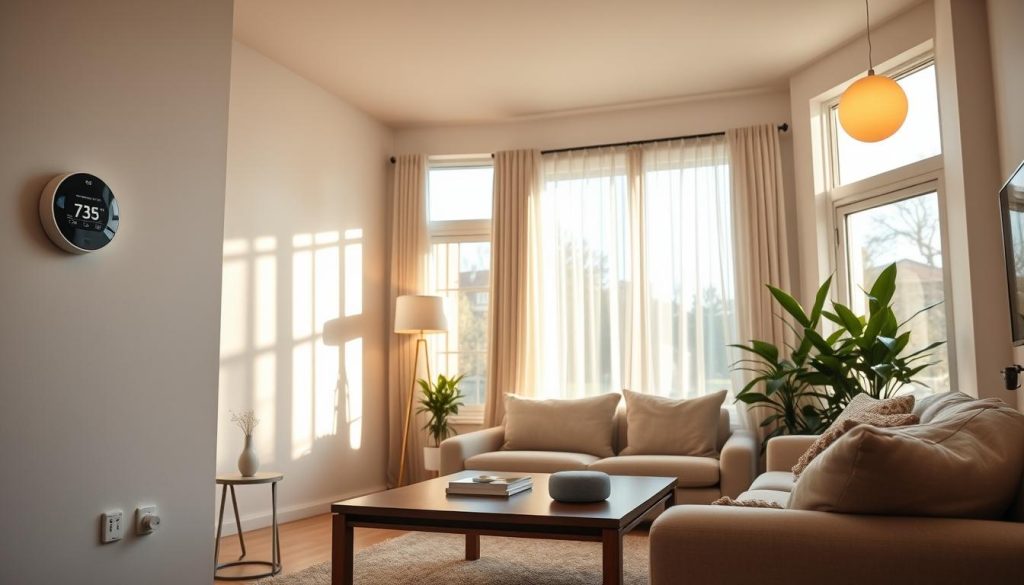
Yes, the starting costs are high. You need to buy devices and have good internet. But, the savings on energy and the increase in home value make it worth it. Smart devices help avoid wasting energy too. NRDC studies show cutting standby energy can reduce your home’s total energy use.
In the end, these innovations save money and help the planet. They improve our homes and lives. With technology always getting better, we’ll see even more savings. It pushes us towards using less energy.
Step-by-Step Upgrades
Starting to make your home smart may feel big. But, you can handle it by adding things one at a time. Start with basics like internet-enabled appliances and remote control stuff. Then, you can add more cool gadgets later.
Picking a main ecosystem is your first step. You can choose from Google Home, Amazon Alexa, or Apple HomeKit. Find the one that fits what you like. Google Home is great for talking to. Amazon Alexa has lots of products. Apple HomeKit is super secure and works well for iPhone users.
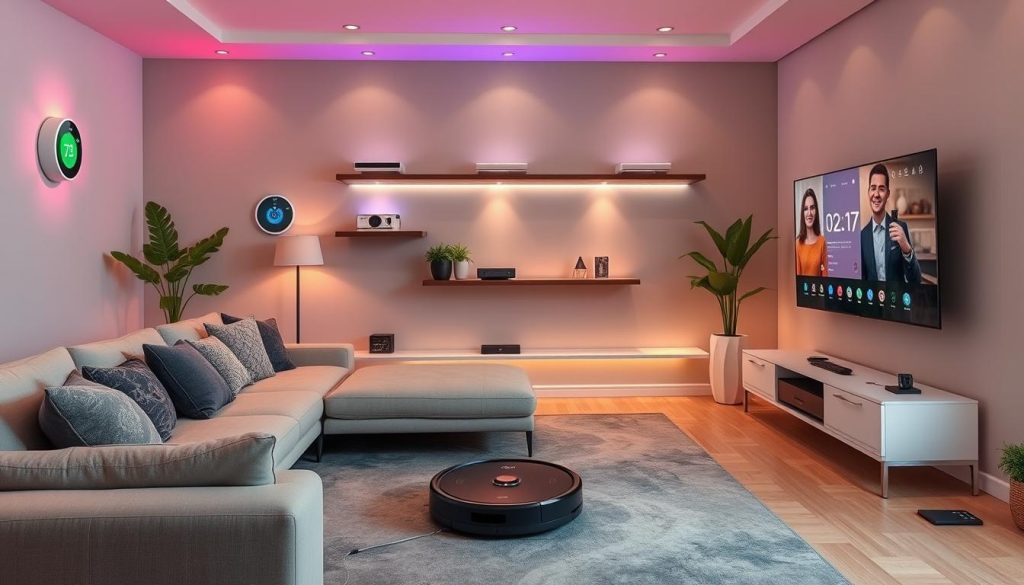
Beginning steps include basic things that make life easier and can save money. For example, smart thermostats like Nest or Ecobee make heating and cooling smarter. Smart lights like Philips Hue change how your home feels and use less power.
After you start, you’ll be ready for more specific updates. Adding smart speakers like Google Home or Amazon Echo makes your home respond to you. For peace of mind, smart locks and cameras help keep your home safe with new tech.
Below, there’s a list of smart things for different parts of your house:
| Area | Smart Appliance | Benefits |
|---|---|---|
| Kitchen | LG Smart Refrigerator | Enhanced food management; integration with recipes and shopping |
| Outdoor | Rachio Smart Irrigation | Weather-adjusted watering schedules; save on water bills |
| Bedroom | Eight Sleep Smart Mattress | Adjustable temperature; sleep tracking for health monitoring |
| Office | Uplift Smart Desk | Ergonomically adjustable; preset heights for comfort |
| Bathroom | Toto Smart Toilet | Auto-cleaning features; heated seats for comfort |
Each upgrade, from basic smart appliances to special gadgets, makes your home better. It also makes your living space more about you. Start with simple things, then add more. And see your home become smart!
Final Tips for Success
Looking into the future of smart home technology shows how important secure integration is. Most smart home devices use passwords. Many also offer extra security steps. Homeowners should use these to keep their devices safe. A weak wireless router exposes your smart home to risks. If your router is old, get a new one with better security. Choose one that works with VPNs if yours is over five years old.
Getting along well with digital assistants like Google Assistant or Amazon Alexa makes life better. Keeping smart thermostats and security systems updated is key. Turn off IoT features you don’t use to lower cyber risks. Using smart thermostats well helps our planet. This aligns with what 64% of consumers want from their utilities. These devices make your home more comfortable and help control energy use.
Using smart home tools offers more than security and ease. It connects you to a growing group that wants a greener lifestyle. Lots of consumers are open to programs that save energy. Offering incentives and talking clearly through social media can boost involvement. It’s important for us all to help with this smart, green future. Keeping up with new tech helps homeowners succeed in the changing world of smart homes.

